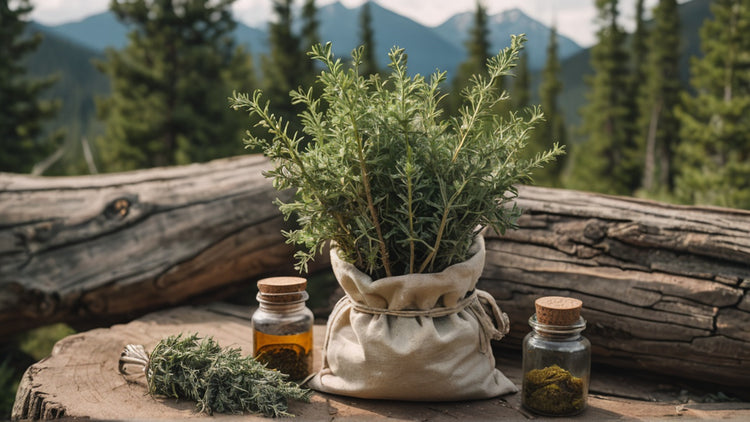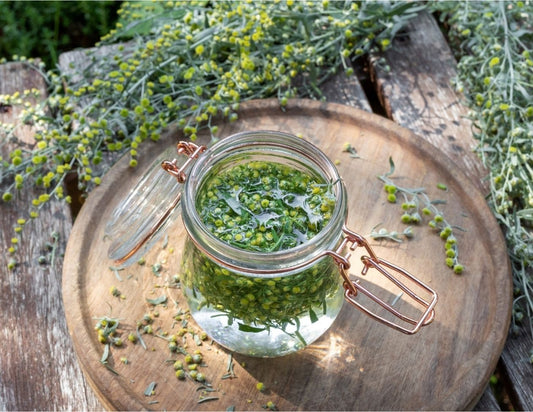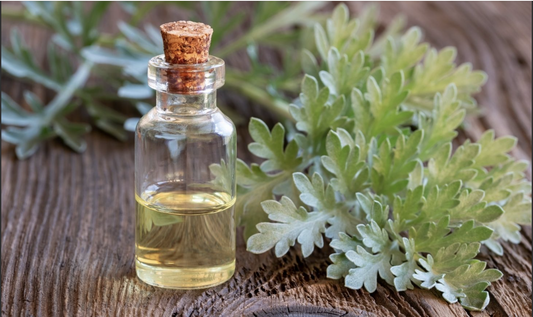Collection: Wormwood
Artemisia absinthium is a woody perennial with finely cut, silvery gray, aromatic foliage. Its small yellow flowers have little ornamental value. Wormwood is useful in beds, borders, and rock gardens, and it makes an excellent foil for bright colors and dark foliage.
Medicinal use of wormwood dates back to Ancient Egypt and wormwood flavored wine was dated to Ancient Greece. Egyptian papyrus scrolls show that as early as 1552, wormwood was used as a tonic and for various ailments, such as rheumatism. ‘Modern’ use of wormwood dates to the 18th century when a specific recipe was patented and sold as a medicinal elixir. The chemical constituents of A. absinthium include thujone, azeulenes which are anti-inflammatory, and sesquiterpene lactones.
As with many herbs there was a wide range of traditional medicinal applications for wormwood. However, it was very well known for its treatment and prevention of intestinal worm infestation. Another popular use was to bring on late menstrual cycles, which indicate restrictions on use for pregnant and breast feeding women. Similar uses were observed for mugwort and there is a similar contradiction is the use of these plants to ease the pain of women in labor.
Other uses included treating many digestive ailments because the chemicals in the plant increase the peristaltic action of the intestinal tract. It was considered good for people suffering from ‘jamming of the gut’ and ‘lethargic digestion’ because wormwood helped ‘move things along’. It was also suggested to improve appetite, help enzyme activity, and be an excellent energizer. Wormwood also treated flu, colds and coughs, and fever. Wormwood may be soaked in a tea infusion and used to make a compress for bruises and bites.
Wormwood (A. absinthium) is extensively cultivated and has been known for its use in several alcoholic drinks, notably Vermouth and Absinthe. In Vermouth, wormwood flower heads were one of several traditional ingredients mixed with strong alcohol. The name vermouth was taken from the German ‘wermut’ for wormwood.
The drink Absinthe has a controversial history due to a ban being placed on the drink (on wormwood in drinks) in many countries in the early 20th Century. The ban was due to the perceived hallucinatory effects of the chemical thujone, contained within the wormwood plant. This was later proved to be incorrect and may have been attributable to the interactions of other ingredients. It must also be remembered that the alcohol content of Absinthe was generally much higher than normal alcoholic drinks.
The drink was featured in the movie Moulin Rouge and has become popular again, but the production process and the quality may be variable. Although the ban on use of wormwood has been eased in many regions the traditional process is more time consuming and costly. Some countries in Europe still make Absinthe in the traditional manner, but most brands rely on artificial essences and colors added to strong alcohol. The traditional green color of Absinthe is from the chlorophyll obtained from using fresh wormwood plants.

-
Sold out Sold out Sold out Sold out Sold outSold out Sold out Sold out Sold out Sold outVendor:My Store
Wormwood - Tincture
Regular price $21.97 USDSale price $21.97 USD Regular priceUnit price / perSold out

